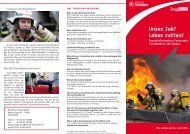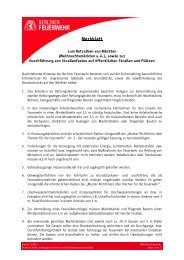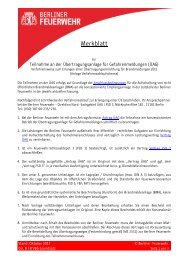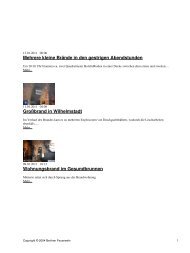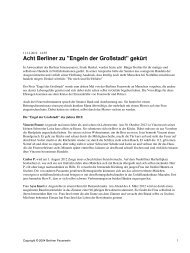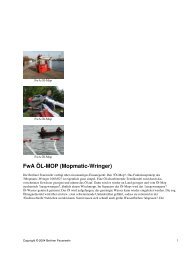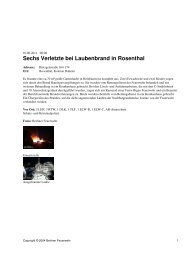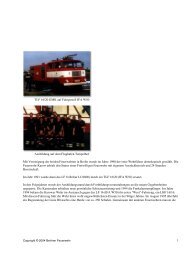Michael Morawitz (52), known as “Mo”, has been a - Berliner ...
Michael Morawitz (52), known as “Mo”, has been a - Berliner ...
Michael Morawitz (52), known as “Mo”, has been a - Berliner ...
Sie wollen auch ein ePaper? Erhöhen Sie die Reichweite Ihrer Titel.
YUMPU macht aus Druck-PDFs automatisch weboptimierte ePaper, die Google liebt.
Of fi re-eaters, thrillseekers<br />
and survival artists
���������������������������<br />
�����������������������<br />
�������������������������������������������������������������<br />
�������������������������������������������������������������������������������������������<br />
������������������������������������������������������������������������������������������������<br />
�������������������������������������������������������������������������������������������<br />
����������������������������������������������������������������������������������������������<br />
������������������������������������������������������������������������������������<br />
�����������������������������������������������������������������������������������
Vorwort<br />
Sehr geehrte Leserin,<br />
sehr geehrter Leser,<br />
auf den folgenden Seiten lernen Sie zwölf <strong>Berliner</strong> Feuerwehrleute<br />
kennen. Gerne hätten wir Ihnen alle 6.462 Menschen<br />
gezeigt, die sich hauptberuflich oder ehrenamtlich<br />
in den Dienst der <strong>Berliner</strong> Feuerwehr gestellt haben, doch<br />
leider reicht der Platz dafür nicht aus. So stehen diese zwölf<br />
stellvertretend für alle Frauen und Männer, Mädchen und<br />
Jungen, die tagtäglich in dieser Stadt dazu beitragen, d<strong>as</strong>s<br />
Menschen in einer akuten Notsituation schnell und kompetent<br />
geholfen wird. Helden gibt es bei uns nicht. Wenn es uns<br />
gelingt, z.B. d<strong>as</strong> Leben eines kleinen Kindes vor den Flammen<br />
zu retten, dann haben viele Menschen daran ihren Anteil. Der<br />
Feuerwehrmann in der brennenden Wohnung ebenso wie die<br />
Disponentin in der Leitstelle, der Ausbilder an der Feuerwehrschule,<br />
der dem Feuerwehrmann die Kenntnisse für eine<br />
solche Rettung vermittelt hat, der Handwerker in unserer Kfz-<br />
Werkstatt oder der Planer im Planungsstab, der die organisatorischen<br />
Voraussetzungen für einen solchen Einsatz schuf.<br />
Eine Feuerwehr ist nur so gut wie ihre Mitarbeiter. Wie gut wir<br />
sind, darüber können Sie sich auf den folgenden Seiten selbst<br />
ein Bild machen.<br />
Foreword<br />
Dear reader,<br />
On the following pages you will get to know twelve fire fighters<br />
from the Berlin fire brigade. We would have really liked to introduce<br />
you to all 6,462, both full-time and voluntary fire fighters<br />
who serve the Berlin area, but unfortunately we simply haven’t<br />
got enough space. So these twelve people represent all the<br />
men, women, girls and boys who, on a daily b<strong>as</strong>is, swiftly and<br />
expertly, come to the help of people in an emergency. We don’t<br />
call these individuals heroes, since rescuing a baby from a<br />
burning house, for example, involves many people: The fire<br />
fighter in the actual flames, <strong>as</strong> well <strong>as</strong> the backroom staff, the<br />
trainer at the fire fighting school who gave the fire fighter the<br />
necessary skills and knowledge, the mechanic in our garage<br />
and the dispatcher at our HQ who plans such deployments.<br />
A fire brigade is only <strong>as</strong> good <strong>as</strong> its staff. And you can decide<br />
for yourself how good we are by reading the following pages!<br />
Wilfried Gräfling<br />
Landesbranddirektor<br />
Deputy Berlin Chief Fire Officer<br />
3
5<br />
Rettungsdienst<br />
Die Notfallrettung, also die Hilfe für akut Verletzte<br />
oder Erkrankte, ist die Hauptaufgabe der <strong>Berliner</strong><br />
Feuerwehr: Knapp 78 Prozent der rund 270.000 jährlichen<br />
Feuerwehr-Einsätze werden in diesem Bereich geleistet.<br />
Wie alle <strong>Berliner</strong> Feuerwehrleute ist auch Brandmeister<br />
Sven Gerling (33) sowohl für die Arbeit im Rettungsdienst<br />
als auch in der Brandbekämpfung und in der technischen<br />
Hilfeleistung ausgebildet. Als Lehrrettungs<strong>as</strong>sistent wird<br />
er meist auf dem Rettungswagen oder dem Notarzteinsatzfahrzeug<br />
eingesetzt. Für ihn ist d<strong>as</strong> kein Problem: „Rettungsdienst<br />
ist für mich etw<strong>as</strong> ganz besonderes. Du hilfst<br />
den Menschen direkt und unmittelbar. Hier habe ich oft<br />
meine größten Erfolgserlebnisse.“ Sven versieht seinen<br />
Dienst in der Feuerwache Neukölln. Hier leben verschiedene<br />
ethnische Gruppen auf engstem Raum. Hinzu kommen<br />
Bereiche mit hoher Arbeitslosigkeit und großer Kriminalität.<br />
D<strong>as</strong> spürt Sven auch im Rettungsdienst. Zehn Einsätze<br />
in einer Zwölf-Stunden-Schicht sind „normal“. Alkohol,<br />
Drogen, Verwahrlosung oder Gewalt sind häufi g die Ursache.<br />
Dabei ist längst nicht in jedem Fall der Einsatz der<br />
Feuerwehr wirklich erforderlich. „Höchstens in zwei von<br />
zehn Fällen geht es wirklich um Leben und Tod“, schätzt<br />
Sven aus seiner Praxis. „Doch w<strong>as</strong> soll‘s: Der Obdachlose<br />
mit dem verstauchten Knöchel – wer kümmert sich um ihn,<br />
wenn nicht wir?“ Sven hilft gerne, doch die Klientel, mit<br />
der er es jeden Tag zu tun hat, macht ihm d<strong>as</strong> oft nicht<br />
einfach. „Die Anspruchshaltung der Patienten ist manchmal<br />
enorm!“ Für die Zukunft wünscht er sich, d<strong>as</strong>s er weniger<br />
zu irgendwelchen Lappalien gerufen wird. „Damit wir<br />
mehr für die da sind, die uns wirklich brauchen!“<br />
Emergency Medical Service<br />
Emergency Medical Service (EMS),<br />
i.e. <strong>as</strong>sistance for seriously injured<br />
or sick people, is the main t<strong>as</strong>ks<br />
of the Berlin Fire Brigade. 78% of the<br />
270,000 annual deployments are carried<br />
out in this fi eld. Like all Berlin’s fi re<br />
fi ghters, Fire Offi cer Sven Gerling (33)<br />
h<strong>as</strong> <strong>been</strong> trained for EMS <strong>as</strong> well <strong>as</strong><br />
fi re fi ghting and technical <strong>as</strong>sistance. As<br />
a trainee paramedic, he is normally <strong>as</strong>signed<br />
to an ambulance rather than a<br />
fi re-fi ghting vehicle. This makes no<br />
difference to Sven: “EMS is something<br />
special for me. You get to help people<br />
directly. I’ve had my greatest sense of<br />
achievement from this kind of work.”<br />
Sven is b<strong>as</strong>ed at a fi re station in Neukölln,<br />
a district with a great deal of<br />
social problems. As with many districts in<br />
the Berlin area, diverse ethnic groups<br />
live here in close proximity to each other.<br />
This is compounded by high rates of<br />
unemployment and crime, and an unattractive<br />
environment. Sven is acutely<br />
aware of this when he is on call. Ten<br />
deployments in a twelve-hour shift is<br />
“normal”. Alcohol, drugs, neglect and<br />
violence are often the cause. However, it<br />
should be remembered that not every<br />
call out requires the fi re brigade. “Two<br />
out of ten call outs at the most are a<br />
matter of life and death”, estimates<br />
Sven, b<strong>as</strong>ed on his own experience.<br />
“Who’s going to take care of the homeless<br />
person who’s twisted his ankle if we<br />
don’t?” Sven is happy to help, but the<br />
people he meets everyday do not always<br />
make it e<strong>as</strong>y for him. “Some of the<br />
patients are very demanding!” For the<br />
future, Sven hopes that there will be<br />
fewer trivial call outs. “So that we can be<br />
there for those who really need us.”<br />
Saving lives is more than just a job!
7<br />
Brandbekämpfung<br />
<strong>Michael</strong> <strong>Morawitz</strong> (<strong>52</strong>), genannt<br />
„Mo“, ist seit 24 Jahren Feuerwehrmann.<br />
Wie viele Einsätze er in<br />
dieser Zeit erlebt hat, weiß er nicht<br />
genau. Aber an seine großen Brandeinsätze<br />
kann er sich noch gut erinnern.<br />
Als „West-Beamter“ kam er 1991<br />
auf die Feuerwache Mitte. Er sollte nur<br />
18 Monate bleiben, aber er ist noch<br />
heute hier. „W<strong>as</strong> ich in dieser Zeit an<br />
Feuern erlebt habe, habe ich noch<br />
nirgendwo anders gesehen.“ Die Bekämpfung<br />
von Bränden macht bei der<br />
Feuerwehr zwar nur 2,5 Prozent aller<br />
Einsätze aus, aber ein Feuer ist immer<br />
noch etw<strong>as</strong> ganz besonderes für<br />
jeden Feuerwehrmann. Mit schwerer<br />
Ausrüstung am Leib, dem Atemschutzgerät<br />
auf dem Rücken und der Atemschutzm<strong>as</strong>ke<br />
vorm Gesicht in ein völlig<br />
verqualmtes Gebäude zu gehen,<br />
ohne zu wissen, w<strong>as</strong> einen dort erwartet<br />
– d<strong>as</strong> kostet schon Über windung.<br />
Drinnen sieht man die Hand vor Augen<br />
nicht, es ist heiß, manchmal über<br />
tausend Grad Celsius, und die merkwürdigsten<br />
Geräusche dringen einem<br />
ans Ohr. Wenn „Mo“ ins Feuer muss,<br />
dann ist auch immer ein bisschen Angst<br />
mit im Spiel. Angst davor, d<strong>as</strong>s man<br />
irgendwo hängen bleibt, d<strong>as</strong>s man sich<br />
im brennenden Gebäude verirrt und die<br />
Luft im Atemschutzgerät nicht reicht.<br />
Oder, d<strong>as</strong>s es mal wieder zur gefürchteten<br />
Durchzündung kommt und buchstäblich<br />
die Luft brennt. Manchmal<br />
wundert er sich über sich selbst, d<strong>as</strong>s er<br />
immer noch Angst hat, nach all den<br />
Jahren, der langen Ausbildung und dem<br />
vielen Training.<br />
Doch Angst ist gut. Sie schützt vor<br />
Leichtsinn und Übermut. Vielleicht ist<br />
„Mo“ gerade deswegen immer wieder<br />
heil aus jedem Feuer herausgekommen.<br />
Draußen ist die Angst im Nu verfl ogen.<br />
Den „Roten Hahn“ besiegt und dabei<br />
vielleicht sogar ein Menschenleben<br />
gerettet zu haben, d<strong>as</strong> ist ein verdammt<br />
gutes Gefühl. Oft ist „Mo“ aber<br />
auch ganz schön sauer, weil er weiß,<br />
d<strong>as</strong>s er gerade mal wieder sein Leben<br />
riskieren musste für jemanden der fahrlässig<br />
oder gar vorsätzlich ein Feuer<br />
verursacht hat.<br />
A fi re is always something special!<br />
Fire fi ghting<br />
<strong>Michael</strong> <strong>Morawitz</strong> (<strong>52</strong>), <strong>known</strong> <strong>as</strong> <strong>“Mo”</strong>, h<strong>as</strong> <strong>been</strong> a<br />
fi reman for 24 years. He cannot say how many<br />
deployments he h<strong>as</strong> had in this time. But he can recall the<br />
biggest fi res all too well. He came from West Germany to join<br />
the Mitte fi re station in 1991. He only wanted to serve for 18<br />
months but is still here. “I’ve never experienced anything like<br />
the fi res I‘ve seen over this l<strong>as</strong>t period.” Actual fi res only<br />
account for 2.5% of all deployments, making them something<br />
special for fi re fi ghters. Entering a burning, smoke-fi lled<br />
building without knowing what to expect, carrying equipment,<br />
including breathing apparatus on your back and the protective<br />
m<strong>as</strong>k on your face, requires real will-power. Once inside, you<br />
cannot see your hand in front of your face, it is hot, sometimes<br />
more than 1,000 degrees and full of strange noises. When<br />
<strong>“Mo”</strong> h<strong>as</strong> to tackle a fi re, there is always an element of fear<br />
involved. Fear of getting trapped somewhere, fear of losing<br />
your way and that the oxygen supply will not be suffi cient.<br />
Alternatively, fear of the dreaded backdraft, when the air<br />
literally burns. Sometimes it surprises him that there is still an<br />
element of fear after all these years on the job and after all the<br />
training courses he h<strong>as</strong> completed. However, fear can be a<br />
good thing. It can protect you from carelessness and cockiness.<br />
Maybe it is “Mo’s” fear that h<strong>as</strong> kept him safe and sound in so<br />
many dangerous situations. Once outside, the fear vanishes<br />
again. Defeating “the dragon”, maybe even saving somebody’s<br />
life, is a great feeling. <strong>“Mo”</strong> often feels anger too, <strong>as</strong> he knows<br />
that sometimes he h<strong>as</strong> to risk his life because somebody h<strong>as</strong><br />
just <strong>been</strong> plain negligent or h<strong>as</strong> even deliberately started a fire.
Technische Hilfeleistung<br />
René Schmücker (40) entstammt einer „Feuerwehrfamilie“.<br />
Sein Vater war schon Feuerwehrmann und<br />
sein Bruder ist bei der Werkfeuerwehr eines Pharmakonzerns.<br />
René selbst trat mit 14 Jahren in die Jugendfeuerwehr ein<br />
und ist seit 21 Jahren hauptberufl ich bei der Feuerwehr.<br />
Aber w<strong>as</strong> heißt hier eigentlich Feuerwehr? Die Bekämpfung<br />
von Feuern macht ja heute nur noch einen geringen Teil<br />
der Einsätze aus. Viel häufi ger leistet die <strong>Berliner</strong> Feuerwehr<br />
technische Hilfe, z. B. nach Verkehrsunfällen, bei<br />
W<strong>as</strong>serrohrbrüchen, Sturmschäden oder Unfällen auf Baustellen<br />
– d<strong>as</strong> Spektrum ist unendlich groß. Für René macht<br />
genau d<strong>as</strong> den Reiz seines Berufes aus: „Du weißt nie, w<strong>as</strong><br />
kommt. Mal hat sich ein Kind den Kopf beim Spielen in<br />
einem Geländer eingeklemmt, mal ist ein LKW auf der Autobahn<br />
umgestürzt, ein anderes Mal treibt ein L<strong>as</strong>tkahn<br />
manövrierunfähig auf der Havel – du wirst täglich neu gefordert!“<br />
Um bei Unfällen jeder Art bestmöglich helfen zu<br />
können, sind die Lösch-Hilfeleistungs-Fahrzeuge (LHF) der<br />
<strong>Berliner</strong> Feuerwehr mit zahlreichen Spezialwerkzeugen und<br />
-geräten für die technische Hilfeleistung ausgestattet. Mit<br />
dem hydraulischen Kombispreizer l<strong>as</strong>sen sich z. B. armdicke<br />
Stahlholme wie Papier durchtrennen. Für besonders<br />
schwierige Einsätze gibt es darüber hinaus auch einen<br />
Technischen Dienst. Diese Spezialeinheit verfügt über zahlreiche<br />
Sonderfahrzeuge und schweres Räumgerät.<br />
You never know what to expect –<br />
that‘s the biggest buzz!<br />
Technical Assistance<br />
René Schmücker (40) comes from a long line of fi re<br />
fi ghters. His father w<strong>as</strong> a fi reman and his brother is<br />
in the company fi re brigade at a large pharmaceutical company.<br />
René joined the junior fi re fi ghters when he w<strong>as</strong> 14<br />
and h<strong>as</strong> <strong>been</strong> a full-time fi reman for 21 years. But what does<br />
the word “fi re brigade” really mean? Fire fi ghting only accounts<br />
for a small amount of the work carried out. Technical<br />
<strong>as</strong>sistance e.g. after a road accident, when pipes burst, dealing<br />
with storm damage or accidents at construction sites to<br />
name but a few, are much more typical of Berlin’s fi re brigade’s<br />
deployments. For Rene, this is what interests him<br />
most about his job: “You never know what’s coming next.<br />
Sometimes a child gets his head stuck between railings,<br />
other times, a lorry overturns on the motorway or a barge<br />
drifts helplessly down the river – every day brings new challenges!”<br />
Berlin’s fi re engines are equipped with numerous<br />
specialised tools and devices so that optimal <strong>as</strong>sistance can<br />
be achieved, regardless of the nature of the<br />
accident. With the hydraulic cutters, for example, thick steel<br />
can be cut through like a knife through butter. There are<br />
additional technical services for particularly diffi cult jobs.<br />
These units have numerous specialised vehicles and heavy<br />
removal equipment at their disposal.
11<br />
Freiwillige Feuerwehr<br />
D<strong>as</strong>s es auch in der Großstadt<br />
Berlin eine Freiwillige Feuerwehr<br />
gibt, ist längst nicht jedem<br />
bekannt. Oberfeuerwehrmann René<br />
Schnell (26) ist einer von rund 1.500<br />
Bürgern, die bei der <strong>Berliner</strong> Feuerwehr<br />
ehrenamtlich Menschen in Not helfen.<br />
Im „richtigen“ Leben repariert der gelernte<br />
Energieelektriker S-Bahnzüge.<br />
Nach Feierabend trainiert er mit seinen<br />
Kameraden von der Freiwilligen Feuerwehr<br />
(FF) Schöneweide für den Ernstfall.<br />
Zum Beispiel den Einsatz beim<br />
Auslaufen gefährlicher Stoffe, ein<br />
Spezialgebiet seiner FF. Säuren binden,<br />
leck geschlagene Fässer umpumpen<br />
oder schadhafte Tanks ab dichten – auch<br />
d<strong>as</strong> sind Aufgaben für die <strong>Berliner</strong><br />
Feuerwehr, für die Berufsfeuerwehr<br />
genauso wie für die Freiwillige Feuerwehr.<br />
René klettert dann in seinen Vollschutzanzug<br />
um mit anzupacken. Der<br />
Anzug ist zwar schwer und man schwitzt<br />
in ihm mehr als in der Sauna, aber so<br />
kann er durch ätzende Flüssigkeiten<br />
und giftige G<strong>as</strong>e waten.<br />
Insgesamt gibt es 59 Freiwillige Feuerwehren,<br />
verteilt über d<strong>as</strong> gesamte<br />
Stadtgebiet. „Feuerwehr ist spannend<br />
und man lernt viel“, sagt René. Weil er<br />
sich verpfl ichtet hat, mindestens<br />
sieben Jahre bei der Freiwilligen Feuerwehr<br />
zu dienen, braucht er nicht zur<br />
Bundeswehr. Aber d<strong>as</strong> ist für ihn nur<br />
sekundär. „Wenn die sieben Jahre um<br />
sind, mache ich bestimmt weiter.“<br />
Volunteer Fire Brigade<br />
Not everyone knows that Berlin<br />
h<strong>as</strong> an volunteer fi re brigade.<br />
Leading Fire Fighter René Schnell (26)<br />
is one of 1,500 citizens who have volunteered<br />
to help people in emergencies.<br />
In “real life”, the qualifi ed electrician<br />
repairs commuter trains for a<br />
living. After work, he trains for emergency<br />
situations with his colleagues in<br />
the volunteer fi re brigade in Schöneweide.<br />
For example, dealing with hazardous<br />
substance spillages, which is a<br />
special fi eld of theirs, binding acids,<br />
securing the contents of leaking barrels<br />
or sealing damaged tanks are all jobs<br />
for Berlin’s fi re brigade – for the fulltime<br />
fi re crews <strong>as</strong> well <strong>as</strong> the<br />
volunteers. René climbs into his protective<br />
clothing and joins in. His suit is<br />
heavy and makes him sweat more than in<br />
the sauna, but by wearing it he can wade<br />
through corrosive liquids and poisonous<br />
g<strong>as</strong>es.<br />
In total there are 59 volunteer fi re<br />
crews, distributed across the entire<br />
city. “Fire fi ghting is exciting and you<br />
learn a lot”, says René. Because he h<strong>as</strong><br />
signed up to the volunteer fi re brigade<br />
for seven years, he does not have to<br />
perform his military service. But this is<br />
only of secondary<br />
importance.“I’m defi nitely going to continue<br />
once the seven years are over.”<br />
There are worse hobbies than helping people
Den ganzen Tag telefonieren – für viele Menschen<br />
vielleicht ein Traumjob. Wenn Hauptbrandmeister<br />
Fredy Brauer (46) Feierabend hat, dann hat er meist genug<br />
vom Telefonieren. Fredy ist Disponent in der Leitstelle der<br />
<strong>Berliner</strong> Feuerwehr. Dies ist eine der größten und modernsten<br />
Feuer- und Rettungsleitstellen Europ<strong>as</strong>. Alle Anrufe über<br />
die Nummer 112 laufen hier ein, d<strong>as</strong> sind über eine Million<br />
Notrufe jährlich. Durchschnittlich 750 Einsätze werden jeden<br />
Tag in der Leitstelle bearbeitet. In Spitzenzeiten (wie z. B. in<br />
der Silvesternacht) können es auch schnell mal über 1.000<br />
Einsätze in zwölf Stunden sein. Über 700 Einsatzfahrzeuge,<br />
verteilt auf f<strong>as</strong>t 100 Standorte, werden von hier aus zu den<br />
Unglücksorten geschickt. Klar, d<strong>as</strong>s dies nur mit Computer-<br />
Unterstützung funktioniert. Der Computer kann viel, aber<br />
nicht alles. „D<strong>as</strong> Gespräch mit dem Menschen, der unsere<br />
Leitstelle<br />
Hilfe braucht, kann kein Computer ersetzen“, weiß Fredy.<br />
Nachdem er viele Jahre Einsatzdienst auf verschiedenen<br />
Feuerwachen versehen hat, ließ er sich vor sechs Jahren in<br />
die Leitstelle versetzen. „Manchmal kann ich bereits bei der<br />
Aufnahme eines Notrufes Tipps zur Ersten Hilfe geben. So<br />
werden die Minuten bis zum Eintreffen der Feuerwehr<br />
überbrückt.“ Auf diese Weise hat Fredy indirekt schon<br />
Menschen ins Leben zurückgeholt und sogar Kinder auf die<br />
Welt gebracht. Die <strong>Berliner</strong> Feuerwehr hat als erste Feuerwehr<br />
in Deutschland ein standardisiertes Notrufabfrageprotokoll<br />
eingeführt. Damit werden Notrufe sehr detailliert<br />
abgefragt und Tipps für Erstmaßnahmen gegeben. So hilft<br />
die Feuerwehr bereits bevor sie am Ort des Geschehens ist –<br />
schneller geht es nun wirklich nicht.
15<br />
Control Centre<br />
Spending the whole day talking on the phone might<br />
seem like a dream job for some people. However,<br />
when Sub Offi cer Fredy Brauer (46) fi nishes work, he h<strong>as</strong><br />
normally had enough of the telephone. Fredy is a dispatcher<br />
in the Berlin fi re brigade’s control centre. It is one of the<br />
largest and most<br />
modern fi re and rescue control centres in Europe. All 112 calls<br />
are directed here, amounting to over one million calls per year.<br />
On average, the control centre processes 750 deployments every<br />
day. At peak times (e.g. on New Year’s Eve) this number can<br />
rise to over 1,000 in a twelve-hour period. More than 700<br />
emergency vehicles stationed at close to 100 locations throughout<br />
the city are sent out to accidents from here. Obviously, this<br />
can only work with the <strong>as</strong>sistance of computers. The computers<br />
can do a lot, but not everything. “Talking to the people who<br />
Dealing with people is the best part of the job<br />
need our help can’t be done by computers”, Fredy knows. After<br />
many years of service at various fi re stations, he transferred to<br />
the control centre six years ago. “Sometimes I can give advice<br />
about fi rst aid when I fi rst receive the call. This often bridges<br />
the gap between the call being made and the arrival of the<br />
EMS.” In this way, Fredy h<strong>as</strong> already indirectly revived accident<br />
victims and even brought a few babies into the world. Berlin’s<br />
fi re brigade w<strong>as</strong> the fi rst one in Germany to introduce a standardised<br />
emergency procedure protocol. This innovation allows<br />
emergency calls to be queried in detail and advice to be given<br />
on preliminary action to be taken. In this way, the fi re brigade<br />
h<strong>as</strong> already started to help before they arrive at the scene – you<br />
can‘t get f<strong>as</strong>ter than that.
My life literally depends on my colleagues when I’m down there
17<br />
Taucher<br />
Tauchen – d<strong>as</strong> ist schon mein<br />
Ding“, sagt Rainer Keck (34). Er<br />
ist einer von 30 Feuerwehrtauchern bei<br />
der <strong>Berliner</strong> Feuerwehr. Rund um die<br />
Uhr stehen vier Taucher bereit, um<br />
Menschen zu retten, die zu ertrinken<br />
drohen, weil sie mit ihrem Segelboot<br />
gekentert oder beim Schlittschuhlaufen<br />
im Eis eingebrochen sind.<br />
Als Rainer noch ein Kind war, nahm ihn<br />
sein Vater oft mit zum Schnorcheln.<br />
Seitdem lässt ihn die Taucherei nicht<br />
mehr los. Schon ein Jahr nach seiner<br />
Feuerwehrmannsausbildung bewarb er<br />
sich bei den Feuerwehrtauchern. D<strong>as</strong><br />
Auswahlverfahren war hart, die dreimonatige<br />
Tauchausbildung noch härter.<br />
Schwimmen, Tauchen, Konditionstraining<br />
und „nebenbei“ einiges an Theorie.<br />
Da kam auch der erfahrene Sporttaucher<br />
oft ins Schwitzen.<br />
Doch mit Sporttauchen ist der Tauchdienst<br />
bei der Feuerwehr ohnehin nicht<br />
vergleichbar. Schillernde Korallenriffe<br />
und imposante Fischschwärme gibt es<br />
in den zahlreichen <strong>Berliner</strong> Gewässern<br />
nicht zu sehen. Es gibt hier überhaupt<br />
nichts zu sehen. Nicht einmal die Hand<br />
vor Augen kann man erkennen. „Ich<br />
muss da unten alles ert<strong>as</strong>ten, Schritt<br />
für Schritt“, erklärt Rainer, „es gibt da<br />
unten keine Orientierung, wenn du dich<br />
zweimal gedreht h<strong>as</strong>t, weißt du nicht<br />
mehr wo unten und oben ist. Mein P<strong>as</strong>smann<br />
bleibt oben an Land oder im Boot<br />
und führt mich mit Signalen wie ein<br />
Goldfisch an der Leine.“ Und w<strong>as</strong> ist im<br />
Vergleich zur Sporttaucherei noch anders?<br />
„Wenn es um Menschenleben<br />
geht, müssen wir schnell sein!“ Vier<br />
Minuten braucht Rainer um seine komplette<br />
Tauchausrüstung anzulegen. Und<br />
zwar während der Fahrt zum Einsatzort<br />
mit Blaulicht und Martinhorn.<br />
Divers<br />
Diving is right up my street”,<br />
says Rainer Keck (34). He is<br />
one of 30 divers in Berlin’s fire brigade.<br />
Four divers are on call 24 hours a day<br />
to save people from drowning whose<br />
sailing boats have capsized or who<br />
have fallen through the ice whilst iceskating.<br />
When Rainer w<strong>as</strong> still a child, his father<br />
often took him with him when he went<br />
snorkelling and he h<strong>as</strong> <strong>been</strong> hooked on<br />
diving ever since. Just one year after he<br />
completed his fire fighting training<br />
course, he applied for a position in the<br />
diving section. The selection process w<strong>as</strong><br />
difficult but the three-month diving<br />
course w<strong>as</strong> even harder: Swimming, diving,<br />
fitness training <strong>as</strong> well <strong>as</strong> theory.<br />
This often proves to be a real challenge<br />
for even the most experienced sports<br />
divers.<br />
But then again, sports diving cannot be<br />
directly compared to diving for the fire<br />
brigade. Shimmering coral reefs and impressive<br />
shoals of fish cannot be seen in<br />
the waters of Berlin. In fact, there is<br />
nothing at all to be seen. You cannot<br />
even see your hand in front of your face.<br />
“I have to really grope around down<br />
there”, explains Rainer. “You cannot orientate<br />
yourself, if you turn round a couple<br />
of times, you don‘t even know which<br />
way is up or down. My partner stays on<br />
the boat or on land and guides me with<br />
signals like a goldfish on a le<strong>as</strong>h.” And<br />
what else is different to hobby diving?<br />
“When it’s a matter of life and death we<br />
have to be <strong>as</strong> quick <strong>as</strong> possible!” It takes<br />
Rainer just four minutes to put his wetsuit<br />
and equipment on, and this is done<br />
on the way to the accident scene with<br />
the blue lights fl<strong>as</strong>hing and sirens
Vorbeugung<br />
Brände machen nur 2,5 Prozent aller Feuerwehreinsätze<br />
in Berlin aus. Nur zweieinhalb Prozent? D<strong>as</strong><br />
sind immerhin noch 7000 Brände in jedem Jahr! Siebentausend<br />
zuviel, wie Branddirektor Bernd Weinhold (45) fi ndet.<br />
Er ist seit mehr als zwanzig Jahren Feuerwehrmann<br />
und hat in dieser Zeit viele Brände gesehen. Er weiß, welche<br />
verheerenden Schäden ein Brand verursachen kann und<br />
welches Leid er für die Betroffenen häufi g bedeutet. Als<br />
Leiter des Grundsatzbereiches „Vorbeugender Brandschutz“<br />
arbeitet Bernd Weinhold daran, d<strong>as</strong>s diese Zahl weiter<br />
deutlich gesenkt wird und die Auswirkungen von Bränden<br />
reduziert werden. „Unser Ziel ist es, d<strong>as</strong> Entstehen von<br />
Bränden zu verhindern und wo uns dies nicht gelingt, wenigstens<br />
die optimalen Voraussetzungen zu schaffen, um<br />
entstehende Brände schnell löschen zu können.“ Dafür<br />
braucht es günstige Möglichkeiten, um beispielsweise Leitern<br />
aufzustellen und um Löschw<strong>as</strong>serleitungen einzuspeisen.<br />
Die notwendigen Schlüssel zu einem Objekt müssen<br />
leicht auffi ndbar sein und eine eindeutige Beschilderung<br />
soll den Einsatzkräften sofort den richtigen Weg zeigen.<br />
Für dieses Ziel arbeiten bei der <strong>Berliner</strong> Feuerwehr 53 Mitarbeiter<br />
des Vorbeugenden Brandschutzes. Bauherren und<br />
Architekten stöhnen manchmal über die Forderungen der<br />
Feuerwehr. „Aber“, d<strong>as</strong> betont Bernd Weinhold mit Nachdruck,<br />
„wir machen d<strong>as</strong> nicht für uns, sondern weil es im<br />
Ernstfall buchstäblich auf Sekunden ankommt.“ Deshalb<br />
sei es auch sehr wichtig, d<strong>as</strong>s die Einsatzkräfte besondere<br />
Objekte in ihrem Ausrückebereich regelmäßig besichtigen,<br />
damit sie im Ernstfall wissen, wo die Gefahren lauern.<br />
Für optimale Vorbeugung muss man erst einmal wissen, wie<br />
ein Brand entsteht und wie er sich dann entwickelt. „Der<br />
Brandanalyse kommt bei uns große Bedeutung zu. Wir sammeln<br />
alle relevanten Daten von Bränden um rechtzeitig Tendenzen<br />
erkennen und gegensteuern zu können.“ Nicht nur im<br />
Baugenehmigungsverfahren, an dem die Feuerwehr gutachterlich<br />
beteiligt ist, sondern auch in der Praxis. „Den Betreibern<br />
baulicher Anlagen von besonderer Art oder Nutzung<br />
bieten die Mitarbeiter des Vorbeugenden Brandschutzes seit<br />
neuestem objektbezogene Beratungen vor Ort an. Hier<br />
geben wir Tipps, wie sie ihren Brandschutz verbessern können.“<br />
Manchmal könnte der Brandschutz schon durch kleine<br />
Maßnahmen effektiv erhöht werden. D<strong>as</strong> gilt übrigens auch<br />
für private Haushalte: Schon für ein paar Euro kann man seine<br />
Sicherheit mit einem Rauchwarnmelder deutlich erhöhen.<br />
D<strong>as</strong> lernen bereits die Kinder, die die Feuerwehr im Rahmen<br />
der Brandschutzerziehung besuchen.<br />
Fire Prevention<br />
Fires only account for two and a<br />
half percent of all fi re brigade<br />
call outs in the Berlin district. Only two<br />
and a half percent? That still means<br />
7000 fi res each year! Seven thousand<br />
too many believes Fire Chief Bernd<br />
Weinhold (45). He h<strong>as</strong> <strong>been</strong> a fi reman<br />
for more than twenty years and h<strong>as</strong><br />
seen a lot of fi res in his time. He knows<br />
the dreadful damage and resulting suffering<br />
that a fi re can cause. As the<br />
head of the fi re prevention section,<br />
Bernd Weinhold is working to lower<br />
this fi gure even further and to reduce<br />
the effects of fi res. “Our objective is to<br />
prevent fi res from starting, and when<br />
this is not possible, to create the optimal<br />
conditions to be able to put them<br />
out <strong>as</strong> quickly <strong>as</strong> possible.” Achieving<br />
this requires favourable circumstances<br />
in order to set up ladders or connect to<br />
the water pipes, for example. The necessary<br />
keys to a property must be close<br />
at hand and clear signs should be in<br />
place to immediately guide the fi re<br />
crews. There are 53 members of the fi re<br />
prevention section in Berlin working<br />
towards this goal. Property developers<br />
and architects may sometimes complain<br />
about the fi re brigade’s<br />
We try to fi ght fi res before they can even start<br />
demands.“But”,emph<strong>as</strong>ises Bernd Weinhold,<br />
“we don’t make these demand for<br />
our sake, but because in an emergency<br />
situation every second is crucial.” This is<br />
why it is also vital that the fi re crews<br />
regularly inspect certain properties, so<br />
that they know where the dangers are<br />
lurking in an emergency situation. Optimal<br />
prevention is achieved when you<br />
know how a fi re starts and how it spreads.<br />
“Fire analysis is becoming more and<br />
more important. We collect all the relevant<br />
data from a fi re to be able to recognise<br />
patterns and take counter me<strong>as</strong>ures<br />
against them in time.” Not just with<br />
planning permission procedures, where<br />
the fi re brigade act <strong>as</strong> consultants, but<br />
also in practice. “The companies responsible<br />
for running buildings with unusual<br />
designs or uses are able to call on the<br />
staff of the fi re prevention section for<br />
property-related advice on site. They receive<br />
tips on how they can improve their<br />
fi re prevention methods.” Sometimes<br />
fi re prevention can be made more effective<br />
by way of relatively small me<strong>as</strong>ures.<br />
This also applies to households: Smoke<br />
detectors, which signifi cantly incre<strong>as</strong>e<br />
fi re safety, can be bought for just a few<br />
Euros. As many children know from the<br />
19
Kat<strong>as</strong>trophenschutz<br />
Auf Leitern klettern, Feuer löschen, Verbände anlegen<br />
– noch vor wenigen Jahren hätte Yvonne Doebel<br />
(39) nicht im Traum geglaubt, d<strong>as</strong>s sie in der Lage ist,<br />
solche Dinge zu tun. Durch ihren Freund kam sie zur Freiwilligen<br />
Feuerwehr. Der hatte sie bald überzeugt, d<strong>as</strong>s Feuerwehr<br />
schon lange keine Männerdomäne mehr ist. Neben<br />
ihrer Arbeit als Sachbearbeiterin beim Amtsgericht hat sie<br />
die Feuerwehrschulbank gedrückt, eifrig gelernt und trainiert.<br />
Inzwischen ist sie schon zur Brandmeisterin befördert<br />
worden und hat viele Einsätze erlebt. Einer ist ihr<br />
besonders in Erinnerung geblieben: Der Hochw<strong>as</strong>sereinsatz<br />
an der Elbe im Jahr 2002. Mehrere Tage und Nächte hat sie<br />
hier mit ihren Kameraden Sandsäcke geschleppt, Hubschrauber<br />
beladen und Straßen freigepumpt. „D<strong>as</strong> war eine<br />
echte Kat<strong>as</strong>trophe“, erinnert sie sich. „Ein schwerer Unfall<br />
oder ein Wohnhausbrand werden häufi g als Kat<strong>as</strong>trophe<br />
bezeichnet. Für die Betroffenen ist es d<strong>as</strong> ja meist auch.<br />
Bei der Feuerwehr reden wir aber erst von einer Kat<strong>as</strong>trophe,<br />
wenn durch ein Ereignis wie z. B. ein Hochw<strong>as</strong>ser oder<br />
einen Sturm große Landstriche und viele Menschen betroffen<br />
sind. Wenn Strom- und W<strong>as</strong>serversorgung zusammengebrochen,<br />
Verkehrswege blockiert sind und die Telekommunikation<br />
gestört ist.“ Klar, d<strong>as</strong>s auch in diesem Fall die<br />
<strong>Berliner</strong> Feuerwehr, die Hilfsorganisationen und d<strong>as</strong> Technische<br />
Hilfswerk helfen – auch über die Grenzen der Stadt<br />
hinaus. Die Hilfe bei Kat<strong>as</strong>trophen erfordert jedoch großen<br />
personellen, materiellen und organisatorischen Aufwand.<br />
Ständig trainieren daher freiwillige und hauptamtliche Helfer<br />
die Zusammenarbeit.<br />
A real dis<strong>as</strong>ter is when everything‘s broken down<br />
Dis<strong>as</strong>ter Control<br />
Climbing up ladders, extinguishing fi res, applying<br />
dressings – a few years ago Yvonne Doebel (39)<br />
would have never dreamt that she would be able to do such<br />
things. She became involved with the volunteer fi re brigade<br />
through her boyfriend. Once she had joined, she soon realised<br />
that the fi re brigade h<strong>as</strong> long since ce<strong>as</strong>ed to be a menonly<br />
organisation. In addition to her job <strong>as</strong> a clerk at the<br />
district court, she studied hard at courses and trained hard,<br />
too. In the meantime, she h<strong>as</strong> <strong>been</strong> promoted to the position<br />
of Leading Fire Fighter and experienced many call-outs.<br />
One of these she recalls in particular: When the river Elbe<br />
broke its banks in 2002. For many days and nights, she<br />
lugged sandbags with her colleagues, loaded helicopters and<br />
pumped water away from the streets. “That w<strong>as</strong> a real dis<strong>as</strong>ter”,<br />
she recalls. “A serious accident or a house fi re is often<br />
referred to <strong>as</strong> a dis<strong>as</strong>ter and for those involved, it generally<br />
is. The fi re brigade, however, only uses the term to<br />
describe things such <strong>as</strong> fl oods or storms where many people<br />
are affected. When electricity and water supplies are cut,<br />
roads are blocked and telephone lines are down, for example.”<br />
Obviously, in such c<strong>as</strong>es, the Berlin fi re brigade, aid<br />
agencies and technical <strong>as</strong>sistance organisations offer help,<br />
and not only in the city itself, but also in the surrounding area.<br />
Helping out in dis<strong>as</strong>ters requires large amounts of personnel,<br />
materials and organisational effort. This is why volunteers and<br />
professional teams constantly simulate such co-operations.<br />
21
Höhenretter<br />
Um Menschen zu retten, hängt Olaf Schmäu (41)<br />
sein Leben jeden Tag buchstäblich an den seidenen<br />
Faden. Olaf ist einer von 30 Höhenrettern bei der <strong>Berliner</strong><br />
Feuerwehr. Der Höhenrettungsdienst wird immer dann<br />
eingesetzt, wenn die Leitern der Feuerwehr nicht mehr<br />
ausreichen. Lebensmüde auf Baukränen; Arbeiter, die in<br />
tiefe Schächte gestürzt sind; lose Bauteile an Hochhäusern<br />
– d<strong>as</strong> alles sind Aufgaben für die Höhenretter. Mit ihrem<br />
Spezialequipment können sie sich aus nahezu jeder Höhe<br />
und an jedem Objekt abseilen – allein, zu zweit oder mit<br />
Krankentrage und notfalls auch kopfüber. Dabei ist Olaf<br />
weder Artist noch Stuntman, sondern „nur“ Feuerwehrmann.<br />
Zusätzlich zu seiner Feuerwehrausbildung hat er die<br />
Ausbildung zum Höhenretter absolviert. Auf der Feuerwache<br />
Marzahn versehen er und seine Kollegen Einsatzdienst<br />
auf dem Lösch-Hilfeleistungs-Fahrzeug oder dem Rettungswagen.<br />
„Nebenbei“ fahren sie jedes Jahr noch ca. 100 Einsätze<br />
als Höhenretter. Hinzu kommt noch jede Menge Training.<br />
Es gibt wohl kaum ein Hochhaus in Berlin, von dem<br />
sich Olaf noch nicht abgeseilt hat. „Die Knoten müssen wir<br />
im Schlaf können. Im Ernstfall muss jeder Handgriff sitzen,<br />
bei Dunkelheit genauso wie bei Frost oder Sturm.“ Trotz<br />
der Mehrbel<strong>as</strong>tung wird die Tätigkeit beim Höhenrettungsdienst<br />
nicht extra vergütet. Der Motivation der Höhenretter<br />
tut dies jedoch keinen Abbruch: „Du wirst hier immer<br />
wieder vor neue Situationen gestellt. Du musst die richtigen<br />
Dinge zur richtigen Zeit tun. Und d<strong>as</strong> nicht nur sicher,<br />
sondern auch schnell.“<br />
It’s the challenge I fi nd stimulating<br />
Height rescue<br />
In order to help people, Olaf Schmäu’s (41) life literally<br />
hangs in the balance everyday. Olaf is one of 30 height<br />
rescuers in the Berlin fi re brigade. This rescue service is used<br />
when the ladders cannot reach the victim. Suicide attempts on<br />
construction cranes, workers who have fallen into deep pits,<br />
loose parts on tower blocks – these are all t<strong>as</strong>ks for the height<br />
rescue crew. With the help of their special equipment, they can<br />
reach almost any height or construction with their ropes, either<br />
on their own, in pairs, with a stretcher, or even suspended<br />
upside down when necessary. Yet Olaf is neither an acrobat nor<br />
a stuntman, “just” a fi reman. In addition to his fi re training,<br />
he also completed height rescue training programmes. B<strong>as</strong>ed<br />
at the fi re station at Marzahn, he and his colleagues carry out<br />
their duties in fi re engines or ambulances. Besides this, they<br />
respond to approximately 100 height rescue call-outs every<br />
year. This means a lot of training. There are almost no tower<br />
blocks left in Berlin that Olaf h<strong>as</strong> not abseiled from. “We need<br />
to be able to tie the knots in our sleep. In an emergency<br />
situation, you have to know exactly what you’re doing, in darkness<br />
<strong>as</strong> well <strong>as</strong> in freezing conditions or storms.” Despite this<br />
additional burden, height rescuers do not receive extra<br />
payment for their efforts. This, however, does not affect their<br />
motivation: “You are constantly facing new challenges in this<br />
job. You have to do the right thing at the right time and not<br />
just safely but quickly.”<br />
23
I really enjoy p<strong>as</strong>sing on my experience!
25<br />
Ausbildung<br />
Auch der beste Feuerwehrmann, die beste Feuerwehrfrau<br />
kann nichts ausrichten, ohne eine entsprechende<br />
Ausbildung, ohne Schutzkleidung, ohne Einsatzfahrzeug<br />
oder ohne eine Unterkunft. Über 800<br />
Beschäftigte sind in acht Serviceeinheiten aktiv, um die<br />
Voraussetzungen zu schaffen, d<strong>as</strong>s die <strong>Berliner</strong> Feuerwehr<br />
schnell und kompetent hilft. Jürgen Wons (59) ist einer<br />
von ihnen. Er ist seit 1978 bei der Feuerwehr und seit 21<br />
Jahren in der Feuerwehrschule tätig. Zwei Jahre dauert die<br />
Ausbildung im mittleren feuerwehrtechnischen Dienst. Neben<br />
Brandbekämpfung und technischer Hilfeleistung<br />
nimmt vor allem der Rettungsdienst einen großen Raum<br />
ein. Nach der Grundausbildung gilt es, regelmäßig Fortbildungen<br />
zu absolvieren. Jürgen ist zuständig für die Ausbildung<br />
in der Wiederbelebung (Reanimation). Seine Kenntnisse<br />
und Erfahrungen an jüngere Kollegen weitergeben zu<br />
können, ist seine Motivation. In ständigem Kontakt mit<br />
Notärzten versucht er die jeweils neuesten Erkenntnisse<br />
der Forschung in seinen Unterricht einfließen zu l<strong>as</strong>sen. Er<br />
weiß: „Die Kollegen können draußen nur so gut helfen, wie<br />
ich sie ausgebildet habe.“ Ausbildung – d<strong>as</strong> ist für ihn<br />
nicht nur die Vermittlung von Theorie, sondern auch ein<br />
vernünftiger Umgang mit den Kollegen. „Es macht mich<br />
stolz, d<strong>as</strong>s mich die meisten auch nach ihrer Ausbildung<br />
immer noch grüßen.“ Generationen von <strong>Berliner</strong> Feuerwehrleuten<br />
sind durch seine Schule gegangen. Zeit, auch<br />
mal wieder selbst Einsätze zu fahren, bleibt da nicht.<br />
„Schade“, findet Jürgen. Doch Menschenleben rettet er<br />
auch als Ausbilder,<br />
zumindest indirekt.<br />
Training<br />
Even the best fire fighter cannot achieve anything<br />
without protective clothing, emergency vehicles, and<br />
accommodation or without the relevant training. Over 800<br />
staff members are active in eight service units so that the<br />
members of the Berlin fire brigade are able to help quickly<br />
and competently. Jürgen Wons (59) is one of them. He h<strong>as</strong><br />
<strong>been</strong> with the fire brigade since 1978 and h<strong>as</strong> <strong>been</strong> involved<br />
in training for 21 years. It takes two years to be trained for<br />
the intermediate level of technical fire fighting. Besides actual<br />
fire fighting and technical <strong>as</strong>sistance, EMS is becoming<br />
more and more significant. Once the b<strong>as</strong>ic training is completed,<br />
there are still further training courses at regular intervals.<br />
Jürgen is responsible for resuscitation training.<br />
P<strong>as</strong>sing on his expertise and experience to younger colleagues<br />
is his incentive. He tries to include the most up-todate<br />
research findings in his lessons through constant contact<br />
with emergency doctors. He knows: “My colleagues on<br />
call are only <strong>as</strong> good <strong>as</strong> the training that I give them.”<br />
Training – this does not only mean explaining theory, but<br />
also teaching how to maintain relationships with colleagues.<br />
“It gives me a sense of pride that most of my ex-students<br />
still say hello to me even after they have completed their<br />
training programmes.” Several generations of Berlin fire<br />
fighters have attended his courses. He no longer h<strong>as</strong> any time<br />
for call-outs himself, which he considers a pity. But indirectly,<br />
Jürgen is still saving lives by doing his job.
Jugendfeuerwehr<br />
Die Zeit bis zu seinem 10. Geburtstag schien für<br />
Colin Wache (12) endlos. Denn erst dann darf man<br />
in die Jugendfeuerwehr eintreten. Seit einem Jahr trägt er<br />
nun stolz den roten Helm und darf schon an den Übungen<br />
und an Zeltlagern teilnehmen. „Es ist ein bisschen schade,<br />
d<strong>as</strong>s sich meine Gruppe nur einmal in der Woche trifft“,<br />
erzählt Colin. Auf dem Hof der Feuerwache in Biesdorf<br />
bringt dann ein erfahrener Kamerad der Freiwilligen Feuerwehr<br />
den Kids die ersten Feuerwehr-Handgriffe bei. D<strong>as</strong><br />
macht Colin großen Spaß. Wenn es nach ihm ginge, könnte<br />
sich seine Gruppe jeden Tag treffen. Und w<strong>as</strong> macht er nun<br />
an den übrigen Nachmittagen? Oft geht er zum Judo. D<strong>as</strong><br />
macht ihm eigentlich nicht so viel Spaß, aber in der Schule<br />
verhauen ihn die Größeren manchmal, erzählt er etw<strong>as</strong><br />
leiser, da muss man sich eben wehren können. Bei der Jugendfeuerwehr<br />
verhaut ihn niemand. Die Größeren hier<br />
sind alle nett und zeigen Colin, wie man Druckverbände<br />
anlegt, Schläuche zusammenkuppelt oder einen Feuerlöscher<br />
bedient. In den nächsten Jahren wird Colin hier sicherlich<br />
noch viel über Erste Hilfe, Brandbekämpfung und<br />
Technische Hilfeleistung lernen. D<strong>as</strong> Wichtigste ist aber<br />
vielleicht: Er wird erfahren, w<strong>as</strong> für ein schönes Gefühl es<br />
ist, in der Gemeinschaft mit anderen, Menschen in Not zu<br />
helfen.<br />
It seemed to be a never-ending wait until Colin Wache<br />
(12) fi nally reached the age of 10 – the minimum age<br />
for membership of the junior fi re fi ghters. He h<strong>as</strong> <strong>been</strong> wearing<br />
the red helmet for a year now and is allowed to take part<br />
in training exercises at the camp. “It’s a shame that my<br />
group only meets up once a week”, explains Colin. An experienced<br />
fi reman from the volunteer brigade teaches the kids<br />
the b<strong>as</strong>ics on the Biesdorf fi re brigade’s courtyard. This is a<br />
lot of fun for Colin. If it were up to him, he would meet up<br />
with his group every day. And what does he do on the other<br />
afternoons? He often goes to his judo cl<strong>as</strong>s. It is not <strong>as</strong><br />
Junior Fire Fighters<br />
much fun, but at school he sometimes gets picked on, he<br />
confi ded in us, and he wants to be able to protect himself.<br />
Nobody picks on him in the junior fi re fi ghters. The older<br />
boys are friendly and show Colin how to apply compression<br />
bandages, how to gather hoses and how to operate a fi re<br />
extinguisher. In the years to come, Colin will also learn<br />
about fi rst aid, fi re fi ghting and technical <strong>as</strong>sistance. But<br />
maybe the most important thing is that he will experience<br />
how good it feels to be part of a community that helps others<br />
in emergencies.<br />
The fi re brigade is cool<br />
27
Museum<br />
Kaum ein anderer kennt sich so gut in der Geschichte<br />
des <strong>Berliner</strong> Lösch- und Rettungswesens aus wie<br />
Hauptbrandmeister Stefan Sträubig (45). Er leitet seit vier<br />
Jahren d<strong>as</strong> Museum der <strong>Berliner</strong> Feuerwehr auf der Feuerwache<br />
Tegel. Seinen zahlreichen Besuchern erzählt er immer<br />
wieder, d<strong>as</strong>s die <strong>Berliner</strong> Feuerwehr, gegründet im Jahre<br />
1851, nicht nur die größte sondern auch die älteste<br />
Berufsfeuerwehr Deutschlands ist. Viele Exponate in diesem<br />
Museum zeugen von der wechselvollen Geschichte der<br />
Feuerwehr in Berlin. Spritzen aus dem 17. Jahrhundert sind<br />
hier ebenso zu fi nden wie Feuermelder aus dem 19. Jahrhundert<br />
und der erste Leitstellen-Computer aus dem vergangenen<br />
Jahrhundert. Stefan Sträubig weiß: „Die Geschichte der<br />
<strong>Berliner</strong> Feuerwehr ist voller Höhen und Tiefen.“ In ihrer<br />
Blütezeit Ende des 19. Jahrhunderts gingen von ihr viele<br />
Impulse für den Brandschutz in ganz Europa aus. Ihre Rolle<br />
im Dritten Reich war ambivalent. Nach dem II. Weltkrieg lag<br />
die <strong>Berliner</strong> Feuerwehr wie die ganze Stadt in Trümmern und<br />
musste erst mühsam wieder aufgebaut werden. Der Teilung<br />
der Stadt infolge des Kalten Krieges folgte auch die Teilung<br />
der Feuerwehr. In ein und derselben Stadt gab es nun zwei<br />
verschiedene Feuerwehren, die sich in den darauf folgenden<br />
40 Jahren völlig unterschiedlich entwickelten. Nach dem Fall<br />
der Mauer und der Wiedervereinigung im Jahr 1990 mussten<br />
die zwei Feuerwehren wieder zu einer Wehr zusammengefügt<br />
werden. Ein Prozess, der 15 Jahre später nahezu abgeschlossen<br />
ist.<br />
Eines hat sich in der über 150-jährigen Geschichte nicht<br />
geändert: Damals wie heute steht die <strong>Berliner</strong> Feuerwehr für<br />
schnelles und entschlossenes Handeln.<br />
It’s the tradition that f<strong>as</strong>cinates me<br />
Museum<br />
Almost nobody knows more about the history of the<br />
Berlin fi re service and EMS than Sub Offi cer Stefan<br />
Sträubig (45). He h<strong>as</strong> <strong>been</strong> running the Berlin fi re brigade’s<br />
museum at the Tegel fi re station for four years now. He<br />
constantly tells the numerous visitors that the fi re brigade,<br />
founded in 1851, is not only the largest but also the oldest<br />
professional fi re brigade in Germany. Many exhibits in the<br />
museum refl ect the chequered p<strong>as</strong>t of Berlin’s fi re brigade.<br />
Nozzles from the seventeenth century, fi re alarms from the<br />
nineteenth <strong>as</strong> well <strong>as</strong> the fi rst control centre computer from the<br />
l<strong>as</strong>t century are all on display. Stefan Sträubig knows: “The<br />
Berlin fi re brigades history is full of peaks and troughs.” In its<br />
heyday at the end of the 19th century, many fi re prevention<br />
innovations originated in Berlin and were adopted all over<br />
Europe. Their role in the Third Reich w<strong>as</strong> ambivalent. After the<br />
Second World War, the Berlin fi re brigade w<strong>as</strong> in ruin, like the<br />
rest of the city, and had to be laboriously built up again. The<br />
division of the city during the Cold War also resulted in the<br />
division of the fi re brigade. At that time, there were two<br />
different fi re brigades in the same city that developed in<br />
completely different ways over the next 40 years. After the fall<br />
of the Wall and reunifi cation in 1990, the two separate entities<br />
had to be reunited. And after 15 years, this process h<strong>as</strong> almost<br />
<strong>been</strong> completed.<br />
One thing, though, h<strong>as</strong> not changed over the l<strong>as</strong>t 150 years –<br />
the Berlin fi re brigade still deals with emergencies quickly and<br />
decisively.
Berlin<br />
Einwohnerzahl population 3 Mio<br />
Gebietsgröße territory 893 km 2<br />
W<strong>as</strong>serflächen surfaces of the water 66 km 2<br />
BAB-Länge im Stadtgebiet length of downtown freeways 68,6 km<br />
Fernverkehrswege im Stadtgebiet downtown transportation routes 723 km<br />
(Personen- u. Güterverkehr, S-Bahn inkl.) (incl. p<strong>as</strong>senger & freight transp. and urban railway)<br />
U-Bahn (Linienlänge) underground 180,1 km<br />
Straßenbahn tramway 430,3 km<br />
Flughäfen airports 2<br />
Häfen harbours 10<br />
Militärische Anlagen (K<strong>as</strong>ernen) military facilities (barracks) 6<br />
Forschungsreaktor research reactor 1<br />
Chemieanlagen chemical engineering facilities 6<br />
<strong>Berliner</strong> Feuerwehr Berlin fire brigade<br />
Anzahl der Berufsfeuerwachen fire stations 38<br />
Notarztwagenstützpunkte ambulance garages 14<br />
Anzahl der Feuerwachen Freiwillige Feuerwehr volunteer fire stations 39<br />
Löschbootstationen fire boat ports 1<br />
Personal Berufsfeuerwehr employees of professional fire brigade 3.826<br />
Anzahl der Freiwilligen Feuerwehren volunteer fire brigades 59<br />
Angehörige der Freiwilligen Feuerwehr members of volunteer fire brigades 1.358<br />
Anzahl der Jugendfeuerwehren junior fire brigades 46<br />
Angehörige der Jugendfeuerwehr members of junior fire brigades 835<br />
Anzahl der Werk- und Betriebsfeuerwehren industrial fire brigades 6<br />
Angehörige der Werk- und Betriebsfeuerwehren members of industrial fire brigades 341<br />
Rettungshubschrauberstützpunkte helicopter b<strong>as</strong>es 1<br />
Notarzt-Stützpunkt der Bundeswehr ambulance of the German Federal Armed Forces 1<br />
Einsätze pro Jahr Operations per year<br />
Zahl der Einsätze „Brandbekämpfung“ fire incidents 8.232<br />
Zahl der Einsätze „Hilfeleistungen“ technical <strong>as</strong>sistance incidents 28.270<br />
Zahl der Einsätze „Rettungsdienst“ EMS incidents 236.138
Fahrzeuge Vehicles<br />
Einsatzleitwagen command vehicles 81<br />
Löschfahrzeuge pumps 181<br />
Tanklöschfahrzeuge special pumps 20<br />
Drehleitern turntable ladders 40<br />
Rettungswagen ambulances 140<br />
Notarztwagen ambulances (advanced life support-physician staffed) 25<br />
Sonstige Rettungsfahrzeuge other EMS vehicles 5<br />
Sonderfahrzeuge special vehicles 133<br />
Abrollbehälter roll-off containers 43<br />
Anhänger trailers 76<br />
Löschboote fire boats 2<br />
Sonstige Boote other boats 91<br />
Kat<strong>as</strong>trophenschutzfahrzeuge rescue vehicles for use in dis<strong>as</strong>ter control 91<br />
Stand 12/2006<br />
Die Freiwilligen – ohne uns geht‘s nicht.<br />
15.000 Einsätze pro Jahr.<br />
15.000 mal Hilfe für Mitmenschen in Not.<br />
15.000 mal gelebter Gemeinsinn.<br />
Landesverband der Freiwilligen Feuerwehren Berlins, 10150 Berlin, Tel. 030/387 10 923 www.lvff-berlin.de
Gliederung der <strong>Berliner</strong> Feuerwehr<br />
Kontakt<br />
1 Einsatz<br />
2 Personal<br />
3 Vorb. Brandschutz<br />
4 Technik u. Gebäude<br />
5 Budget<br />
FW Berufsfeuerwachen<br />
FF Freiwillige Feuerwehren<br />
SP Stützpunkte<br />
RS Rettungsdienststützpunkte<br />
LB FF - N<br />
Vertreter des Landesbeauftragten<br />
FF<br />
<strong>Berliner</strong> Feuerwehr<br />
Voltairestr. 2, 10179 Berlin<br />
Postanschrift <strong>Berliner</strong> Feuerwehr, 10150 Berlin<br />
Tel. (+49 30) 387 – 111 Fax (+49 30) 387 10 939<br />
E-Mail: Pressestelle@<strong>Berliner</strong>-Feuerwehr.de<br />
Impressum<br />
Herausgeber <strong>Berliner</strong> Feuerwehr, Stab Öffentlichkeitsarbeit/Pressestelle (2005) Idee & Konzept Jens-Peter Wilke, eobiont GmbH<br />
Design & Produktion eobiont GmbH Übersetzung James Hardy Englische Redaktion Nigel J. Luhman Druck Königsdruck<br />
Fotos Rolf-Dieter Erbe, Dr. Alexander Grzegorzweski, Thom<strong>as</strong> Kristandt, Achim Laggies, Ulrich Lindert, Detlef Machmüller,<br />
Jochen Tack, Marco Trenn, Sven Schneider, Thom<strong>as</strong> Schröder, Thom<strong>as</strong> Stibbe, Stefan Sträubig, Jens-Peter Wilke, Ruth Wimmer,<br />
Museum der <strong>Berliner</strong> Feuerwehr, Spreepicture, ZDF Portraitfotos Jens-Peter Wilke<br />
Noch mehr Infos unter:<br />
Dir W<br />
Direktion West<br />
1 Einsatz<br />
2 Personal<br />
3 Vorb. Brandschutz<br />
4 Technik u. Gebäude<br />
5 Budget<br />
FW Berufsfeuerwachen<br />
FF Freiwillige Feuerwehren<br />
SP Stützpunkte<br />
RS Rettungsdienststützpunkte<br />
LB FF - W<br />
Vertreter des Landesbeauftragten<br />
FF<br />
Dir S<br />
Direktion Süd<br />
1 Einsatz<br />
2 Personal<br />
3 Vorb. Brandschutz<br />
4 Technik u. Gebäude<br />
5 Budget<br />
FW Berufsfeuerwachen<br />
FF Freiwillige Feuerwehren<br />
SP Stützpunkte<br />
RS Rettungsdienststützpunkte<br />
LB FF - S<br />
Vertreter des Landesbeauftragten<br />
FF<br />
SE EL Einsatzlenkung, Leitstelle<br />
SE FI Finanzen und Innere Dienste<br />
SE BG Bau und Grundstücke<br />
SE AF Aus- und Fortbildung<br />
SE FG Fahrzeuge und Geräte<br />
Technischer Dienst<br />
SE IT Informationstechnik<br />
1* Personalrat<br />
2* Frauenvertretung<br />
3* Schwerbehindertenvertretung<br />
4* Jugend- und Auszubildendenvertretung<br />
www.eobiont.de



